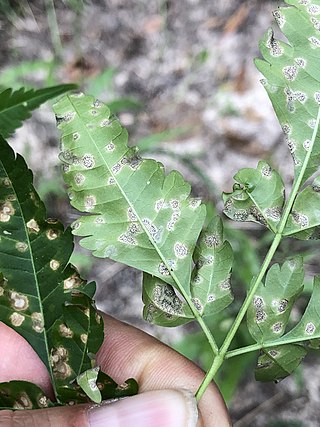Blight refers to a specific symptom affecting plants in response to infection by a pathogenic organism.

Hevea brasiliensis, the Pará rubber tree, sharinga tree, seringueira, or most commonly, rubber tree or rubber plant, is a flowering plant belonging to the spurge family Euphorbiaceae originally native to the Amazon basin, but is now pantropical in distribution due to introductions. It is the most economically important member of the genus Hevea because the milky latex extracted from the tree is the primary source of natural rubber.

Melia azedarach, commonly known as the chinaberry tree, pride of India, bead-tree, Cape lilac, syringa berrytree, Persian lilac, Indian lilac, or white cedar, is a species of deciduous tree in the mahogany family, Meliaceae, that is native to Indomalaya and Australasia.

Ixora is a genus of flowering plants in the family Rubiaceae. It is the only genus in the tribe Ixoreae. It consists of tropical evergreen trees and shrubs and holds around 544 species. Though native to the tropical and subtropical areas throughout the world, its centre of diversity is in Tropical Asia. Ixora also grows commonly in subtropical climates in the United States, such as Florida where it is commonly known as West Indian jasmine.
Pseudocercospora cannabina is a fungal plant pathogen infecting hemp. Cercospora cannabina was originally found on the leaves of Cannabis sativa in Uganda. Then in 1976, it was renamed as Pseudocercospora cannabina by mycologist Frederick Claude Deighton (1903-1992).
Pseudocercospora fuligena is a fungal plant pathogen infecting tomatoes. It is the cause of the fungal disease black leaf mold. The fungus was first described in the Philippines in 1938 and has since been reported in numerous countries throughout the tropics and subtropics. It was reported in the United States in 1974, initially in Florida, and has since been reported in non-tropical regions including Ohio and North Carolina.
Pseudocercospora mali is a fungal plant pathogen infecting Apple trees. It was originally found on the living leaves of Pyrus malus in Louisiana, USA.
Pseudocercospora purpurea is a fungal plant pathogen that causes a leaf spot on the avocado. Species Cercospora purpurea was originally found on the leaves of Persea species in Georgia, USA in 1878. before the species was transferred to the Pseudocercospora genus in 1976.
Pseudocercospora rhapisicola is a fungal plant pathogen infecting palms.

Pseudocercospora subsessilis is a fungal plant pathogen infecting chinaberry tree. It is widespread in tropical and subtropical areas on host species of the genera Azadirachta and Swietenia.
Pseudocercospora theae is a fungal plant pathogen infecting tea. It was originally found on the fallen leaves of Thea viridis in Italy.

Pseudocercospora vitis is a fungal plant pathogen which causes isariopsis leaf spot,.
Mycosphaerella musicola is a fungal plant pathogen, which is the causal agent of Yellow Sigatoka leaf spot disease on banana plants.
Pseudocercospora kaki is a fungal plant pathogen, who causes leaf spot of persimmon. It was originally found on leaves of Diospyros kaki in Taiwan. Some examples of other host species are Diospyros hispida, Diospyros lotus, Diospyros texana, and Diospyros tupru.

Malus sieboldii, commonly called Siebold's crab, Siebold's crabapple or Toringo crabapple, is a species of crabapple in the family Rosaceae.

Pseudocercospora is a genus of ascomycete fungi. An anamorphic version of the genus Mycosphaerella, Pseudocercospora species are plant pathogens, including the causal agent of the so-called South American leaf blight of the rubber tree. The widely distributed genus is concentrated predominantly in tropical regions. Pseudocercospora was circumscribed by Italian-Argentinian botanist Carlos Luigi Spegazzini in 1910.
Pseudocercospora arecacearum is a fungus. It was originally found on the fronds of Rhopalostylis sapida in northern New Zealand, and it was published in 2006, along with other Pseudocercospora species; Pseudocercospora gunnerae and Pseudocercospora pandoreae.
Pseudocercospora gunnerae is a fungal plant pathogen. It was found originally on the leaves of Gunnera tinctoria in northern New Zealand.
Pseudocercospora pandoreae is a fungus.

William Brown was a British mycologist and plant pathologist, known for his ground-breaking research on fungal physiology and the physiology of plant parasitism by fungi, carried out in 1912–28. Born in rural Scotland and educated at the University of Edinburgh, he spent nearly all his career at the Imperial College of Science and Technology in London, where he created the plant pathology research school in the 1920s, becoming Britain's first professor of plant pathology in 1928, and heading the department of botany (1938–53). He was president of the Association of Applied Biologists and the British Mycological Society. He studied Botrytis cinerea, which causes grey mould in a variety of plants, and various Fusarium species that attack apples.







